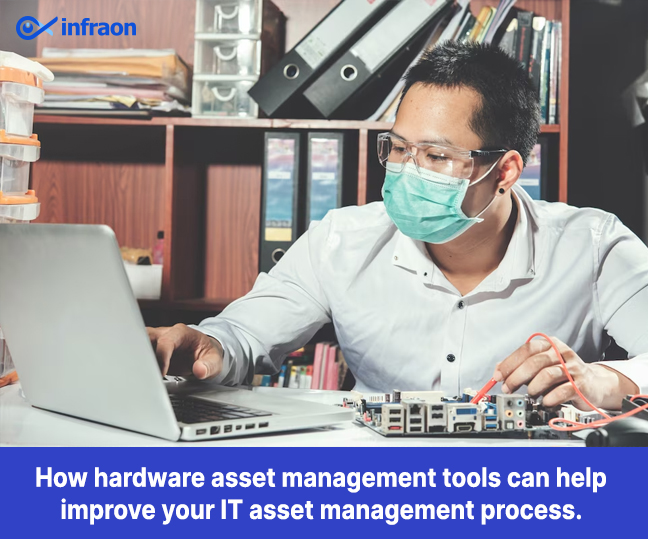The efficient management of hardware assets is crucial for successful IT asset management, and it starts from procurement until retirement. However, without streamlined procedures and dedicated software, this process can become cumbersome and prone to errors.
Manual and decentralized tracking solutions are inaccurate, difficult to maintain, and can lead to higher overhead costs, lost assets, and mismanagement. This also makes it challenging to accurately assess the company’s overall compliance status.
Thus, the adoption of hardware asset management software is the best practice for businesses to manage their IT infrastructure. According to Gartner, organizations that implemented such solutions experienced a 30{49ad122cf4cd715c50edb12b8286b8b60b6ae4913bf58abe885abb4552ddfbec} reduction in overhead costs in the first year and 5{49ad122cf4cd715c50edb12b8286b8b60b6ae4913bf58abe885abb4552ddfbec} in the following years.
HAM Tool Helps to Improve IT Asset
Hardware assets come with a hefty price tag for procurement, configuration, maintenance, and security. Additionally, the effort required to manage them is substantial, and they tend to lose value quickly.
However, implementing Hardware Asset Management can yield significant benefits for organizations. Notably, this discipline can improve operations throughout the enterprise, leading to positive economic outcomes. These advantages include:
Prevent asset loss and theft
Efficient hardware asset management software handles the entire life cycle of a company’s assets, from acquisition to disposal. This includes asset tagging, ownership assignment, location monitoring, and routine maintenance. By utilizing this solution, businesses can easily track every aspect of an asset’s work status, physical whereabouts, and disposition.
Moreover, you can accurately record equipment warranty information, maintenance and service records, contract agreements, and licensing compliance and renewal. Collecting and analyzing all this information reduces the risks of fraudulent activities and theft, providing IT teams with clarity on all available assets and how they are being utilized. IT teams can also identify which assets are idle or underutilized, allowing them to make proactive purchase decisions when existing assets are near retirement.
Enhance productivity
Adopting a hardware asset management process liberates valuable resources, allowing your staff to concentrate on fundamental responsibilities. Automating erstwhile inefficient and manual operations boosts productivity and facilitates greater output.
Moreover, hardware asset management software assists in anticipating and identifying potential problems before they impede operations. Furthermore, integrating ITSM tools such as Zendesk or Jira will enable staff to effortlessly link assets to tickets, check them out, and assign them accordingly.
Improve security & compliance
With a proper system in place, you’ll have a complete, up-to-date list of all hardware assets and their versions. This enables easy prioritization of security measures to protect your company’s assets from potential threats. The system also notifies you of assets in need of servicing or retirement, so you can address issues before they become vulnerabilities.
Auto Checkouts
Deploying hardware assets in bulk from various sources in your inventory management software can lead to duplicated assets in your database. Utilizing HAM Agent, Intune, or JamfPro might result in importing some devices, causing duplication when merging them. Luckily, a robust system will detect and list all duplicated IT assets, allowing you to manage them effectively.
Why is HAM important for Organizations?
Hardware Asset Management holds immense significance in today’s technology-driven organizations, particularly in managing complex IT infrastructures. It enables precise tracking, maintenance, and optimization of hardware assets throughout their lifecycle.
Through effective hardware asset management practices, organizations can make informed decisions regarding procurement, minimize unnecessary costs, mitigate security risks, ensure regulatory compliance, streamline maintenance processes, and enhance overall operational efficiency.
With the implementation of a robust hardware asset management strategy, businesses can optimize resource allocation, bolster system reliability, and drive long-term success in the digital landscape.
Conclusion
Effective hardware asset management is not something to be postponed. It has far-reaching implications on employee productivity, financial stability, and overall security, making it a crucial undertaking for any organization.
Infraon’s a top-tier hardware asset management software, is designed to meet your IT asset management needs by leveraging industry best practices. It seamlessly integrates with essential business and IT systems, providing a comprehensive solution for managing hardware assets efficiently. With Infraon, organizations can ensure optimal asset utilization, streamline processes, and enhance overall operational effectiveness.



